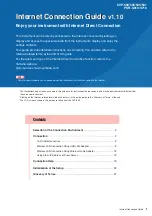
Control Sources
Descriptions of Control sources
25-8
42
Global FUN 4 (GFUN4)
When the Globals parameter on the COMMON page is turned on, FUN 4 becomes
global, and is labeled GFUN4. This control source does not appear in the Control
Source list for parameters whose functions are local.
43
Volume Control (VolCtl)
This control source will always respond to MIDI controller 07 messages. Assign
this value to a parameter when you want MIDI volume messages to affect the pa-
rameter.
44
Pan Control (PanCtl)
This control source always responds to MIDI controller 10 messages. Assign this
value to a parameter when you want MIDI pan messages to affect the parameter.
45
Balance Control (BalCtl)
This control source will always respond to MIDI controller 08 messages. Assign
this value to a parameter when you want MIDI balance messages to affect the pa-
rameter.
46
Channel Count (ChanCnt)
This control source keeps track of the total number of active voice channels (how
many notes are playing), and converts the number into a control signal between 0
and +1. The control signalÕs value is 1 when all 48 voice channels are active, and 0
when no voice channels are active.
You can use this control source in several ways. One example is to limit the volume
of each note so that you have a more nearly constant volume regardless of how
many notes youÕre playing (this is independent of the effect of attack velocity on
volume). To set this up, you would go to the F4 AMP page in the Program Editor,
and set the Src1 parameter to a value of ChanCnt. Then set the Depth parameter to
a negative value. This will decrease the overall amplitude of each note as you play
more simultaneous notes. This example works best with short-release sounds. ItÕs
great for an organ program, for example.
Channel count is also useful for controlling the modulation applied to a sound. For
example, you may have a sound what you use both as a lead and for rhythm. Sup-
pose you want a deep vibrato when youÕre soloing, but less vibrato when youÕre
playing chords. Set up the vibrato by using LFO1 as the value for the Src2 param-
eter on the PITCH page in the Program Editor. Set the MinDpt parameter to 72 cts,
and the MaxDpt parameter to 12 cts. Then set the value of the DptCtl parameter to
ChanCnt, and YouÕll get maximum vibrato depth when only one note is active.
(Channel count outputs a control signal of 0 when no notes are playing, so with
only one note playing, its value is near 0, which causes the DptCtl parameter to
generate a value near its minimum: 72 cents in this case.)
If you want to increase the depth of the vibrato as you increase the number of ac-
tive notes, set the value of the MaxDpt parameter higher than that of the MinDpt
parameter.
NOTE: There are no control sources that correspond to the numeric entries 47Ñ54.
Содержание K2500RS
Страница 12: ...Table of Contents TOC 12...
Страница 16: ...Introduction How to use this manual 1 4...
Страница 32: ...User Interface Basics The Panel Play Feature K2vxR 3 8...
Страница 106: ...Effects Mode and the Effects Editor Configurations and Parameters 9 24...
Страница 186: ...Song Mode Recording Multi timbral Sequences via MIDI 12 52...
Страница 304: ...DSP Functions Hard Sync Functions 14 52...
Страница 394: ...Programs Setups and Keymaps K2500 ROM Keymaps 21 12...
Страница 402: ...LFOs LFO Shapes 23 4...
Страница 406: ...Note Numbers and Intonation Tables List and Description of Intonation Tables 24 4...
Страница 434: ...DSP Algorithms 26 14...
Страница 450: ...MIDI and SCSI Sample Dumps SMDI Sample Transfers 29 8...
Страница 464: ...Glossary 31 6...
Страница 490: ...K2vx Program Farm VOX K25 Appendix A 22...
Страница 494: ...K2vx Compatibility Converting programs from the K2vx to K2000 Appendix B 4...
















































